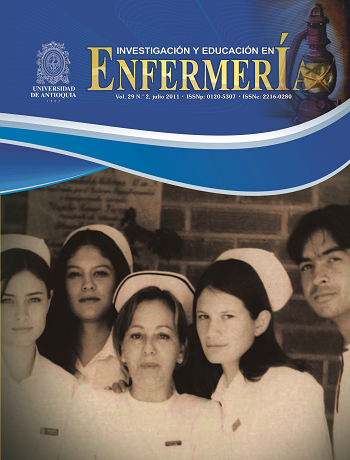Incorrect use of medicines by patients post cerebrovascular accident
DOI:
https://doi.org/10.17533/udea.iee.4847Keywords:
Stroke; drug utilization; nursing.Abstract
Objective. To evaluate how patients cerebrovascular accidents (CVA) victims use their medicines at home.
Methodology. Cross sectional study. A representative sample of 30 patients who received home care in the city of Rio de Janeiro (Brazil) in 2008 was studied. Information about CVA risk factors and the medicines they were taking was collected using a structured interview to the patients, and the DRUGDEX® classification system was used to determine the correct or incorrect use of the medicines.
Results. Participants were mostly elder women. The average of medicines per patient was of 3.3 medicines. The main reasons for mistaking were: taking medicines with food, and taking other medicines at the same time. The highest proportions of incorrect administration of medicines in more than 50% of the doses were: Spironolactone, glibenclamide, and atenolol (each of them with a 100.0%), simvastatin (87.5%), captopril (72.5%) and NPH insulin (66.7%).
Conclusion. A great proportion of patients after having suffered a CVA use their medicines prescribed for home treatment incorrectly.
Downloads
References
(1) Mackay J, Mensah GA. The atlas of heart disease and stroke. Geneva: world health organization; 2004.
(2) Brasil. Ministério da Saúde. Datasus Informações de Saúde: estatísticas vitais- mortalidade e nascidos vivos, 2006 Brasil [internet]. 15 capitais e distrito federal. Rio de Janeiro: Ministério de Saúde: 2006. Disponible em: http://tabnet.datasus.gov.br/cgi/deftohtm.exe?sinasc/cnv/nvRJ.def.
(3) Sacco RL. Adam R, Albert G, Alberts MJ, Benavente O, Furie K et al. Guidelines for prevention of stroke in patients with ischemic stroke or transient ischemic attack: a statement for healthcare professionals from the American Heart Association/American Stroke Association Council on Stroke: co-sponsored by the Council on Cardiovascular Radiology and Intervention: the American Academy of Neurology affirms the value of this guideline. Stroke. 2006;37(2):577-617.
(4) Pires SL, Gagliardi RJ, Gorzoni ML. Study of the main risk factors frequencies for ischemic cerebrovascular disease in elderly patients. Arq Neuropsiquiatr. 2004;62(3B):844-51.
(5) Brasil. Resolucao da Diretoria Colegiada. nº11, Regulamento Técnico de Funcionamento de Serviços que prestam Atenção [internet]. Brasil: Agencia Nacional de Vigencia Sanitaria. 2006. [Acesso 2008 Ago 28]. Disponible en: http://www.saude.sp.gov.br/resources/profissional/acesso_rapido/gtae/saude_pessoa_idosa/rdc_anvisa.pdf.
(6) Tejada TLM, Pastor DMP, Gutiérrez ESO. Efectividad de un programa educativo en el control del enfermo con diabetes. Invest Educ Enferm. 2006;24(2):48-53.
(7) Brasil. Ministério da Saúde. Relação Nacional de Medicamentos Essenciais: RENAME. [Internet]. Brasilia: MS; 2009 [Acesso 2008 ago 27]. Disponible en: http://bvsms.saude.gov.br/bvs/publicacoes/07_0516_M.pdf
(8) Micromedex.Drug interation.Thomson Healthcare [Internet].2009.[Acesso 2009 Ago 27]. Disponible en: http://www.thomsonhc.com/hcs/librarian/ND_T/HCS/ND_CPR/Interactions/ND_PR/Interactions/CS/8E3308/DUPLICATIONSHIELDSYNC/14008E/ND_PG/PRIH/ND_B/HCS/ND_P/Interactions/PFPUI/zJ16h3o2YC7Sio/PFActionId/hcs.Interactions.FindDrugInteractions
(9) Lessa I. Doenças Crônicas não Transmissíveis no Brasil: um desafio para a complexa tarefa da vigilância. Ciênc Saúde Coletiva. 2004;9(4):931-43.
(10) Clayton BD, Stock YN. Farmacologia na prática de enfermagem. 13ª ed. Rio de Janeiro: Elsevier; 2006.
(11) Organização Pan-Americana da Saúde/Organização Mundial da Saúde; Ministério da Saúde. Avaliação da Assistência Farmacêutica no Brasil: estrutura, processo e resultados. [Monografia en internet]. Brasília: 2005. Disponible en:: http://www.opas.org.br/medicamentos/site/UploadArq/HSE_ASF_REM_1205.pdf
(12) Bocchi SCM. O papel do enfermeiro como educador junto a cuidadores familiares de pessoas com AVC. Rev Bras Enferm. 2004;57(5):569-73.
Downloads
Published
Versions
- 2025-01-22 (2)
- 2011-08-22 (1)
How to Cite
Issue
Section
License

This work is licensed under a Creative Commons Attribution-NonCommercial-ShareAlike 4.0 International License.
Derechos de propiedad / Direitos de Propriedade
English: If the article is accepted for publication, all copyright will be of exclusive property of Investigación y Educación en Enfermería. The text and the graphics included in the publication are exclusive responsibility of the authors and not necessarily reflect the thought of the Editorial Committee.
Español: Si el artículo es aprobado para publicación, todos los derechos son de propiedad de Investigación y Educación en Enfermería. El texto y las gráficas incluidas en la publicación son de exclusiva responsabilidad de los autores y no necesariamente refleja el pensamiento del Comité Editorial.
Português: Se o artigo for aceito para publicação, todos os direitos autorais serão de propriedade exclusiva de Investigación y Educación en Enfermería. O texto e os gráficos incluídos na publicação são de responsabilidade exclusiva dos autores e não refletem necessariamente o pensamento do Comitê Editorial.















